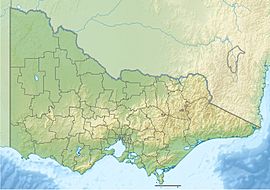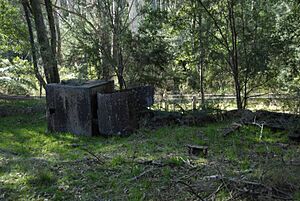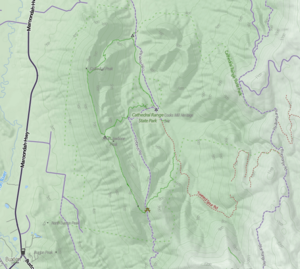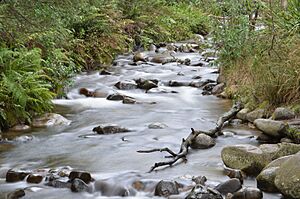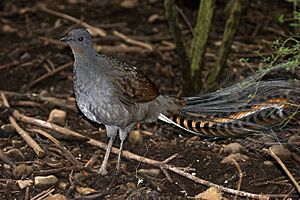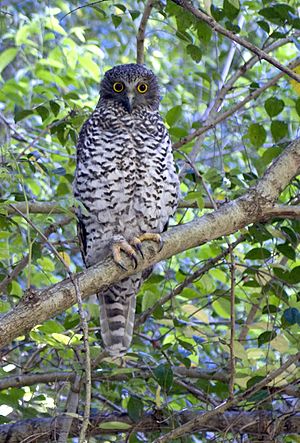Cathedral Range State Park facts for kids
Quick facts for kids Cathedral Range State ParkVictoria |
|
|---|---|
|
IUCN Category II (National Park)
|
|
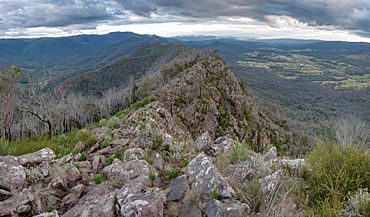
The ridge of the Cathedral Range looking south
|
|
| Nearest town or city | Buxton |
| Area | 3,577 hectares (8,840 acres) |
| Managing authorities | Parks Victoria |
| Website | Cathedral Range State Park |
| See also | Protected areas of Victoria |
The Cathedral Range State Park is a beautiful natural area in Victoria, Australia. It's about 100 kilometres (62 mi) north-east of [Melbourne]. The park is located between the towns of Buxton and Taggerty. It runs alongside the Maroondah Highway.
The Cathedral Range became a State Park on 26 April 1979. It covers 3,577 hectares (about 8,800 acres). The park features rugged peaks, a river called Little River, and forested hills. Because it's close to Melbourne, many people visit for day trips or weekend adventures. Popular activities include bushwalking, camping, rock climbing, and abseiling. Cathedral Range State Park helps protect nature and offers great outdoor fun.
Contents
History of Cathedral Range State Park
European settlers first arrived in the Acheron area in 1839. They chose land for a large farm called Acheron Run. Seven years later, in 1846, the Taggerty Run was set up. This area included the Cathedral Range.
The land in the Cathedral Range was very difficult. It had rocky soils and steep slopes. This made it hard for settlers to build homes there. Instead, they used the land for grazing animals until the 1930s. Wild dogs then became a big problem for the animals.
After grazing stopped, logging and milling began. This happened from the 1930s to the 1970s. The Cathedral Mill, now known as Cooks Mill, started in 1938. It was near where Little River and Storm Creek meet. The mill closed in 1955, but logging continued until 1971. Today, you can still see parts of Cooks Mill. It is protected as a historic site in the park.
Aboriginal Heritage
The traditional owners of the land around the Cathedral Range are Aboriginal people. They are members of the Wurundjeri tribe and speak the Taungurong language. An important area for the Taungurong people is in the Acheron River valley. This valley is west of the State Park.
Aboriginal Affairs Victoria has found two special sites in the park. One site has a scarred tree. This means a tree was marked by Aboriginal people long ago. The other site has a single old tool or item. These sites show the long history of Aboriginal people in the area.
Geology and Land Features
The Cathedral Ranges are made of sandstone and shale. These rocks formed over 400 million years ago. This was during the Upper Silurian period. Over time, wind and water wore down these rocks. This created the amazing peaks we see today.
The range is about 7 kilometers (4.3 miles) long. It is also about 1.5 kilometers (0.9 miles) wide. The highest point is Sugarloaf Peak, at 923 meters (3,028 feet) tall. It is at the southern end of the range. The second highest peak is Cathedral North Peak, at 814 meters (2,671 feet). These two peaks are separated by a narrow dip called the Jawbone saddle.
The eastern side of the park is next to the Cerberean Caldera. This was formed by a huge volcanic eruption. This happened about 374 million years ago. So, the rocks in this area are a mix of sedimentary and volcanic types. The soils are mostly red clays. These clays are good at resisting erosion.
Rivers in the Park
Cathedral Range State Park has two rivers that flow all year. They are Little River and Storm Creek. Little River flows towards the north-west. It then joins the Acheron River in Taggerty. The town of Taggerty gets its water directly from Little River.
The river flows through the park's camping and picnic areas. This means we need to be careful not to pollute the water. Storm Creek meets Little River near Cooks Mill in the park. River levels can rise quickly after heavy rain. Flooding is common in the area. The last big flood was in 1996. It caused a lot of damage to Little River Road.
Biodiversity: Plants and Animals
Cathedral Range State Park is home to many different kinds of plants and animals. Some plant and animal groups are very important here. There are also some rare species living in the park.
Flora: The Plants
The park has many types of plant communities. These include forests with rich herbs, dry grassy forests, damp forests, and riverbank forests. The plants change depending on where you are. Along Little River, you'll find tall Manna Gum trees. Above 900 meters, there are Myrtle Beech forests.
The dry, rocky slopes have open forests. Here, you can see red stringybark (Eucalyptus macrorhyncha). You'll also find broad-leaved peppermint (Eucalyptus dives) and long-leaved box (Eucalyptus goniocalyx). The moist river valleys have candlebark gum (Eucalyptus rubida) and narrow-leaved peppermint (Eucalyptus radiata). At the top of Sugarloaf Peak, there are snow gum trees (Eucalyptus pauciflora). Just below this, you'll find alpine ash (Eucalyptus delegatensis) down to Sugarloaf Saddle.
A special plant community in the park is the mix of myrtle beech (Nothofagus cunninghamii) and woolly tea-tree (Leptospermum lanigerum). This group of plants is rare. It is only found in one other place, Baw Baw National Park.
The park also has many native orchids. They bloom in spring and summer. Some of these orchids are the alpine greenhood (Pterostylis alpina), pink fingers (Caladenia carnea), wax lips (Glossodia major), and the bird orchid.
Some rare plant species live in the park too. These include the bristle-fern (Cephalomanes caudatum). It is rare in Victoria. The slender tick-trefoil (Desmodium varians) is also poorly known in Victoria. There are also some common tussock-grasses that are rare here.
Fauna: The Animals
The park's different plants, climates, rivers, and landforms create many homes for native animals. A study in 1996 found many animals here. It found seventeen native mammals, eight reptiles, one amphibian, one fish, and eighty-seven native birds.
Common animals you might see include the common wombat (Vombatus ursinus). There are also eastern grey kangaroo (Macropus giganteus) and the superb lyrebird (Menura novaehollandiae). You might also spot the peregrine falcon (Falco peregrinus) and satin bowerbird (Ptilonorhynchus violaceus).
A native freshwater fish, the Mountain galaxias (Galaxias olidus), was seen in Little River. This was just before the Little River falls. These falls might stop trout, a major predator, from reaching the galaxias. Sometimes, people also see the platypus (Ornithorhynchus anatinus) in Little River.
Rare Animal Species
The 1996 animal survey found some rare species. These are important to protect.
Leadbeater's Possum The Leadbeater's possum (Gymnobelideus leadbeateri) is a famous Australian animal. It is listed as critically endangered. This means it is at very high risk of disappearing forever. It lives in wet ash forests in Victoria. Its numbers have dropped because of logging, bushfires, and fewer old trees with hollows.
No Leadbeater's Possums have been seen in Cathedral Range itself. But they have been seen only 3 km south of the park. The Alpine Ash forest in the park is a good home for this possum.
Brush-tailed Phascogale The brush-tailed phascogale (Phascogale tapoatafa) is a small, meat-eating marsupial. It is active at night. It is listed as "near threatened" globally and "rare" in Victoria. We don't know exactly why its numbers are falling. But losing its preferred home is likely a reason. There are no official records of this animal in the park. However, the park has good habitat for it, so it might be there.
Powerful Owl The powerful owl (Ninox strenua) is Australia's largest owl. It is listed as "threatened" in Victoria. These owls have been seen resting along Little River. It is thought that at least one pair of Powerful Owls lives in the park.
Sambar Deer The sambar deer (Rusa unicolor) are large deer from South-East Asia. They were brought to Victoria in the 1860s for hunting. There are worries about how these introduced deer affect the environment. However, in Victoria, they are considered wildlife. There are not many Sambar Deer in Cathedral Range State Park. But their numbers need to be watched. This will help reduce any harm they might cause to the park's plants and animals.
Environmental Threats
The plants and animals in Cathedral Range State Park face threats. These come from introduced plants, animals, and diseases.
Threats from Plants
Many introduced plants have become pests in the park. Four main plants are big threats to the environment here. These are blackberry, tutsan (Hypericum androsaemum), Japanese honeysuckle (Lonicera japonica), and Monterey pine (Pinus radiata). Blackberry is a very invasive plant. It is listed as a weed that causes major problems across Australia. Japanese honeysuckle has been found along the park's rivers. Monterey pine trees are spreading into the park from nearby pine plantations.
Threats from Animals
Introduced animals that hunt local wildlife include foxes, feral cats, and feral dogs. Studies show that many Australian animals are killed each year by these predators. Feral goats have also been seen near the park. Feral goats harm the environment by eating too much vegetation. They also damage the soil with their hooves.
Threats from Diseases
Studies on diseases in the park have not been done yet. The cinnamon fungus (Phytophthora cinnamomi) has not been found here. This fungus causes serious damage to plant communities. Myrtle wilt is thought to be in the park. It is caused by a fungus called Chalara australia. This fungus infects myrtle beech trees and slowly kills them. This disease has been suggested as a potentially threatening process.
Park Management
Cathedral Range State Park is managed by Parks Victoria. They work to protect the park's natural beauty, cultural sites, and scenery. At the same time, they make sure visitors can enjoy many activities. Parks Victoria has six main goals for managing the park:
- To give special protection to important plants and animals.
- To control or get rid of pest plants and animals.
- To continue protecting and explaining the history of Cooks Mill.
- To improve and organize the camping facilities.
- To check climbing sites for erosion and other impacts.
- To promote the park as a special place with amazing scenery, nature, and fun activities.
Ongoing management of Cathedral Range State Park is very important. It helps keep the area's cultural history and natural ecosystems safe. It also protects rare plant and animal species. And it allows everyone to enjoy the park's spectacular landscape.


